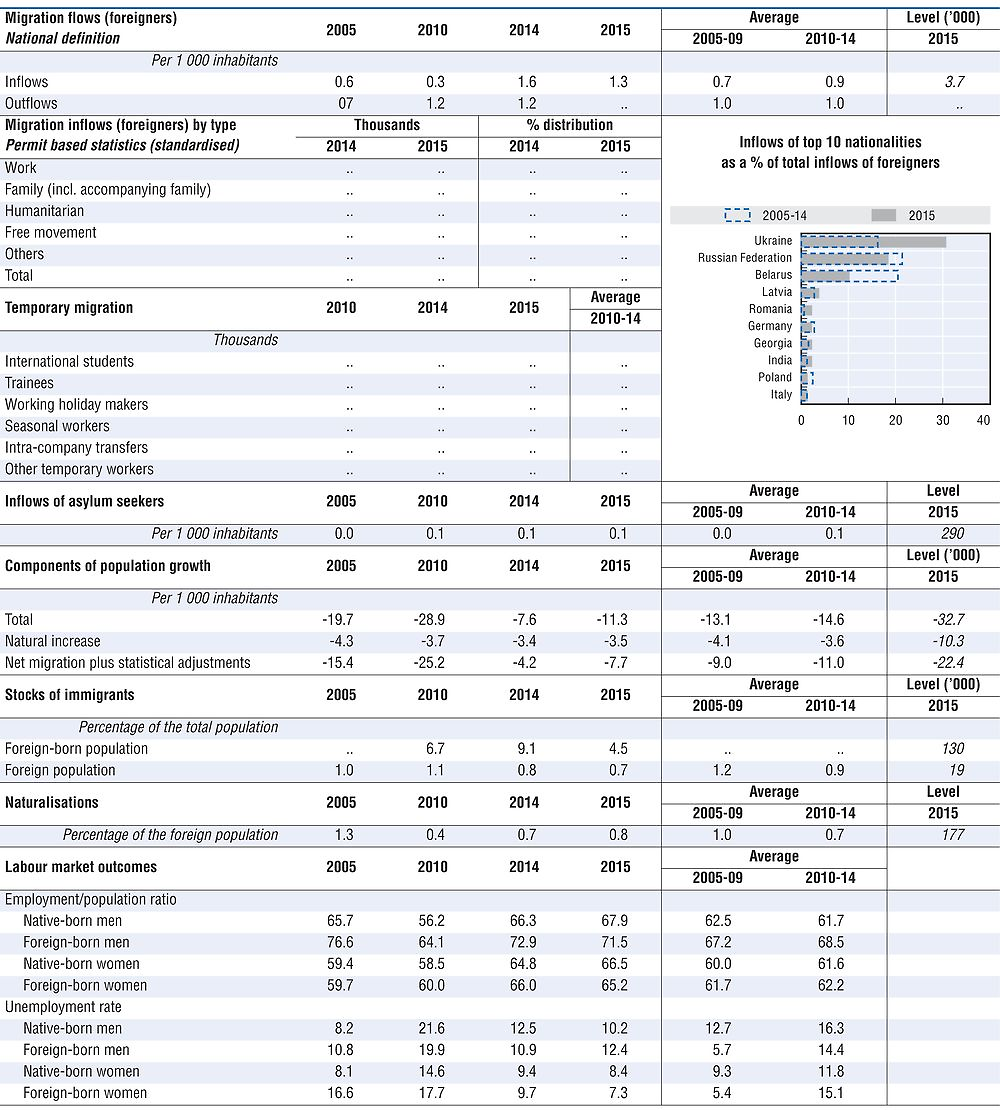Lithuania
The Lithuanian population has continued to fall, from 3 million at the 2011 census to an estimated 2.85 million at the beginning of 2017. The number of foreign nationals residing in Lithuania increased by 0.8% over 2016 to 44 600 at the beginning of 2017, equivalent to 1.6% of the total population. Non-EEA citizens accounted for 86% of foreign residents. Of these, almost half held long-term residence permits.
Lithuania has one of the highest emigration rates in Europe, with outflows continuing to increase. In 2016, 50 300 people left Lithuania, compared with 44 500 in 2015 and 36 600 in 2014. In 2015, the United Kingdom remained the main destination (43%), followed by Germany (7%), Ireland (7%) and Norway (6%). Forty-nine per cent of all emigrants in 2015 were aged between 20 and 34 years and more than 80% were Lithuanians.
Immigration fell to 22 100 and 20 200 in 2015 and 2016, respectively, slightly less than in the previous two years but still substantially higher than the record low of 5 200 in 2010. No data are yet available on the characteristics of immigrants in 2016, but in 2015, 83% were returning Lithuanian nationals and 31% of the foreign nationals were Ukrainians. Net emigration in 2016 stood at 30 200, substantially higher than the level in 2015 (22 400).
Lithuania did not receive a large influx of asylum seekers in 2016, although the number of applications rose to 425 from 180 in 2015 according to the Migration Department. Almost half came to Lithuania as resettled/relocated foreigners from Greece and Turkey; most were Syrians. Refugee status was given to 180 and 14 received subsidiary protection. Lithuania has committed to taking 170 displaced persons under the EU burden-sharing commitments.
On 11 August 2016, the Lithuanian Government and the International Organization for Migration Office in Vilnius signed a Framework Agreement to cooperate in resettling of up to 410 asylum seekers from Turkey. On 7 September 2016, the first 20 migrants were resettled.
Some 1 200 and 1 400 people had their citizenship reinstated in 2015 and 2016, respectively, compared with 1 080 in 2014. This procedure applies to persons who held Lithuanian citizenship before 15 June 1940 or their descendants, and who were expelled from Lithuania or left the country for political reasons. A further 70 applicants of Lithuanian descent gained citizenship via a simplified procedure (110 in 2016). Around 180 foreign citizens were naturalised each year in 2015 and 2016.
Since 2015, some accompanying family can gain residence. This concerns families accompanying certain categories of migrants, including teachers at some educational institutions, investors meeting specific thresholds for job creation or financial investment; intra-corporate transfers; and those granted subsidiary protection. The last category had previously been subjected to a two-year residence requirement prior to bringing in family members.
On 1 January 2017, the Startup visa, aimed at foreigners who intend to engage in lawful activities related to new technologies or other significant innovative economic and social development, became active. Enterprise Lithuania evaluates applications in terms of business plan and the qualifications of the applicant. The permit is for one year, renewable, and foreign recipients may bring accompanying family members.
On 20 June 2016, the Lithuanian Government adopted a special Action Plan aimed at reducing emigration and increasing return migration. The Action Plan addresses different areas influencing migration choice, including: promotion of enterpreneurship and job-creation; attracting investors and talents; increasing salaries and improving social services; improving migration procedures; strengthening ties with the diaspora; improving information services and targeted dissemination of information about Lithuania and its living and work conditions. This plan does not have a separate budget line and all measures must be implemented within regular Ministerial operating budgets.

